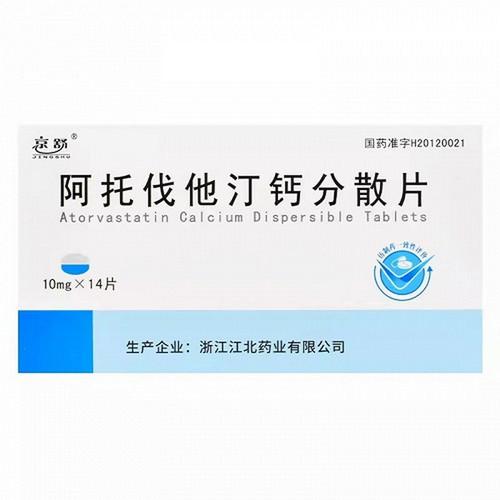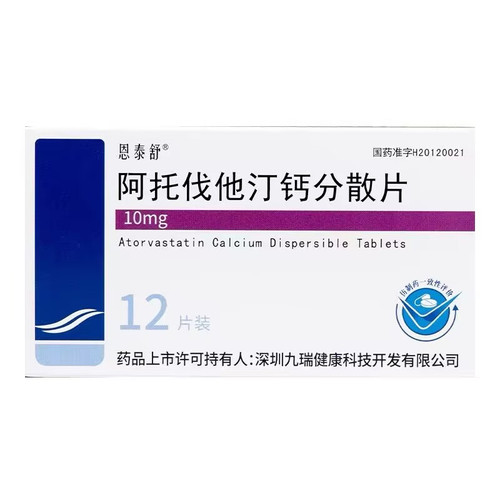Product Overview
[Drug Name]
Generic Name: Atorvastatin Calcium Dispersible Tablets
Trade Name: Jingshu Atorvastatin Calcium Dispersible Tablets 10mg x 14 tablets
[Main Ingredient]
Atorvastatin calcium.
[Appearance]
White powder.
[Indications/Main Functions]
Hypercholesterolemia; patients with coronary heart disease or coronary heart disease-related critical illnesses (e.g., diabetes, symptomatic atherosclerotic disease) combined with hypercholesterolemia or mixed dyslipidemia.
[Specifications]
10mg x 14 tablets
[Dosage and Administration]
This product can be swallowed orally orally. It can also be dispersed in an appropriate amount of boiled water before oral administration. The usual starting dose is 10mg once daily. Dose adjustments should be made every 4 weeks or longer. The maximum dose is 80mg once daily. Atorvastatin can be taken once daily at any time of day, regardless of mealtime.
[Adverse Reactions]
(1) The most common adverse reaction of this product is gastrointestinal discomfort, and others include headache, rash, dizziness, blurred vision and taste disturbance. (2) It may occasionally cause a reversible increase in blood aminotransferase. Therefore, liver function needs to be monitored. (3) Rare adverse reactions include impotence and insomnia. (4) Rare adverse reactions include myositis, myalgia, and rhabdomyolysis, which are manifested as muscle pain, fatigue, fever, and are accompanied by increased blood creatine phosphokinase and myoglobinuria. Rhabdomyolysis can lead to renal failure, but it is rare. (5) The combination of this product with immunosuppressants, folic acid derivatives, niacin, gemfibrozil, erythromycin, etc. may increase the risk of myopathy. (6) There have been reports of hepatitis, pancreatitis and allergic reactions such as angioedema.
[Contraindications]
This product should not be used by those who are allergic to it, and should be used with caution by those with allergic constitutions.
[Drug Interactions]
(1) This product can prolong the prothrombin time when used in combination with oral anticoagulants, increasing the risk of bleeding. (2) This product can increase the risk of myolysis and acute renal failure when used in combination with immunosuppressants such as cyclosporine, erythromycin, gemfibrozil, and niacin. (3) Colestipol and cholestyramine can reduce the bioavailability of this product, so this product should be taken 5 hours after the former.
[Precautions]
(1) Blood cholesterol and blood creatine phosphokinase should be checked regularly during medication. Blood aminotransferase may increase when using this product. Patients with a history of liver disease should also monitor liver function tests regularly when taking this product. (2) If blood aminotransferase increases to 3 times the upper limit of normal, or blood creatine phosphokinase increases significantly, or there are signs of myositis or pancreatitis during treatment with this product, this product should be discontinued. (3) If hypotension, severe acute infection, trauma, metabolic disorder, etc. occur when using this product, attention should be paid to the possible occurrence of renal failure secondary to myolysis. (4) The dosage of this product should be reduced in case of renal insufficiency. (5) This product should be taken with food to facilitate absorption. (6) Dietary therapy is always the first choice for treating hyperlipidemia. Increasing exercise and reducing weight are better than any form of medicine. Please read the instructions carefully and use it according to the doctor's instructions.
[Use in children]
The use of this product in children should be judged by a specialist. The experience of treating this product in children is limited to a small number of patients (4 to 17 years old) with severe lipid disorders such as homozygous familial hypercholesterolemia. The recommended starting dose of this product in this patient population is 10 mg per day. Based on the patient's response and tolerance, the dose can be increased to 80 mg per day. There is no safety data on the growth and development of this product in this population.
[Use in elderly patients]
The efficacy and safety of atorvastatin calcium in elderly people over 70 years old are no different from those in the general population.
[Overdose]
There is no special treatment for overdose of this product. In the event of overdose, the patient should take symptomatic and supportive treatment measures as needed. Patients should have their liver function checked and serum creatine phosphokinase levels monitored. Hemodialysis does not significantly accelerate the clearance of atorvastatin due to its substantial drug binding to plasma proteins.
[Pharmacology and Toxicology]
Atorvastatin is a selective, competitive inhibitor of HMG-CoA reductase, the rate-limiting enzyme that converts 3-hydroxy-3-methyl-glutaryl-CoA to mevalonate (a precursor of sterols, including cholesterol). Triglycerides and cholesterol are combined in the liver to form very-low-density lipoprotein cholesterol (VLDL) and released into the plasma for further distribution to peripheral tissues. Low-density lipoprotein cholesterol (LDL) is formed from VLDL and is primarily metabolized through receptors with high affinity for low-density lipoprotein cholesterol (LDL). Atorvastatin lowers plasma cholesterol and serum lipoprotein concentrations by inhibiting HMG-CoA reductase and cholesterol biosynthesis in the liver. It also enhances LDL uptake and metabolism by increasing hepatic LDL receptors on cell surfaces. Atorvastatin reduces LDL cholesterol production and LDL cholesterol particle number. Atorvastatin causes a significant and sustained increase in LDL cholesterol receptor activity, leading to beneficial changes in the mass of circulating LDL cholesterol particles. Atorvastatin effectively lowers LDL cholesterol levels in patients with homozygous familial hypercholesterolemia, a condition for which lipid-lowering drugs are generally ineffective. Clinical safety data indicate that atorvastatin is not carcinogenic in rats. The maximum dose in rats, calculated on a mg/g basis, was 63-fold higher than the maximum human dose (80 mg/day); the AUC(0-24) value, derived from total inhibitory activity, was 8.16-fold higher in rats. In a two-year study in mice, the maximum dose in mice, calculated on a mg/g body weight basis, was 250-fold higher than the maximum human dose. The incidence of hepatocellular adenomas in male rats and hepatocellular carcinomas in female rats increased at the maximum dose. Systemic doses in mice, calculated on an AUC(0-24), were 6-11-fold higher than those in humans. Four in vivo studies and one in vitro study conducted with and without metabolic activation have demonstrated that atorvastatin is not mutagenic or clastogenic. In animal studies, doses up to 175 mg/g/day were used in males and 225 mg/kg/day in females. Atorvastatin did not affect animal fertility and was not teratogenic.








